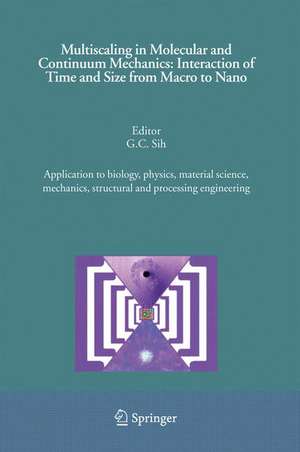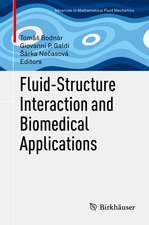Multiscaling in Molecular and Continuum Mechanics: Interaction of Time and Size from Macro to Nano: Application to biology, physics, material science, mechanics, structural and processing engineering
Editat de G. C. Sihen Limba Engleză Hardback – 23 oct 2006
| Toate formatele și edițiile | Preț | Express |
|---|---|---|
| Paperback (1) | 953.20 lei 6-8 săpt. | |
| SPRINGER NETHERLANDS – 19 oct 2010 | 953.20 lei 6-8 săpt. | |
| Hardback (1) | 963.47 lei 6-8 săpt. | |
| SPRINGER NETHERLANDS – 23 oct 2006 | 963.47 lei 6-8 săpt. |
Preț: 963.47 lei
Preț vechi: 1174.96 lei
-18% Nou
Puncte Express: 1445
Preț estimativ în valută:
184.35€ • 192.50$ • 152.24£
184.35€ • 192.50$ • 152.24£
Carte tipărită la comandă
Livrare economică 15-29 aprilie
Preluare comenzi: 021 569.72.76
Specificații
ISBN-13: 9781402050619
ISBN-10: 1402050615
Pagini: 478
Ilustrații: XVIII, 460 p.
Dimensiuni: 155 x 235 x 24 mm
Greutate: 0.96 kg
Ediția:2007
Editura: SPRINGER NETHERLANDS
Colecția Springer
Locul publicării:Dordrecht, Netherlands
ISBN-10: 1402050615
Pagini: 478
Ilustrații: XVIII, 460 p.
Dimensiuni: 155 x 235 x 24 mm
Greutate: 0.96 kg
Ediția:2007
Editura: SPRINGER NETHERLANDS
Colecția Springer
Locul publicării:Dordrecht, Netherlands
Public țintă
ResearchCuprins
“Deborah numbers”, coupling multiple space and time scales and governing damage evolution to failure.- A multi-scale formulation for modeling of wrinkling formation in polycrystalline materials.- A multiscale field theory: Nano/micro materials.- Combined loading rate and specimen size effects on the material properties.- Discrete-to-continuum scale bridging.- Micromechanics and multiscale mechanics of carbon nanotubes-reinforced composites.- Multi-scale analytical methods for complex flows in process engineering: Retrospect and prospect.- Multiscaling effects in low alloy TRIP steels.- Ductile Cr-Alloys with solute and precipitate softening.- A multi-scale approach to crack growth.- Continuum-based and cluster models for nanomaterials.- Segmented multiscale approach by microscoping and telescoping in material science.- Mode I segmented crack model: Macro/symmetry, micro/ anti-symmetry and dislocation/skew-symmetry.- Tensegrity architecture and the mammalian cell cytoskeleton.- Mode II segmented crack model: Macro/skew-symmetry micro/anti-symmetry and dislocation/skew-symmetry.- Microstructure and microhardness in surface-nanocrystalline Al-alloy material.- Grain boundary effects on fatigue damage and material properties: Macro- and micro-considerations.- Coupling and communicating between atomistic and continuum simulation methodologies.
Caracteristici
For the first time, a book addresses how results from one scale can be shifted or related to another scale, say from macro to micro or vice versa This is a new topic that is not well known up to now The disciplines in classical mechanics and physics rarely consider relating the results at the different scales such as macro to micro or to atomic. The new approach retains the use of the equilibrium mechanics within a scale level such that cross scale results can be connected by scale invariant criteria Engineers in different disciplines should be able to understand and use the results. They include those in physics, chemistry, mechanics, biology, material science, etc. The topics treated are of an interdisciplinary character











